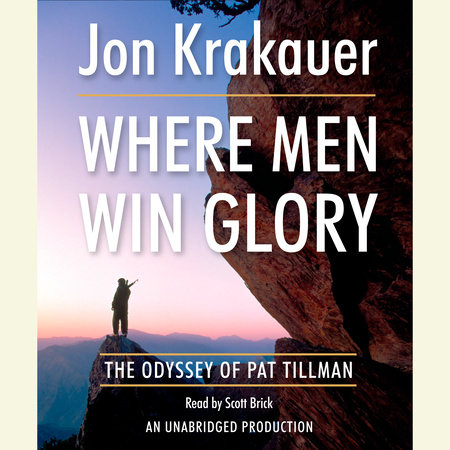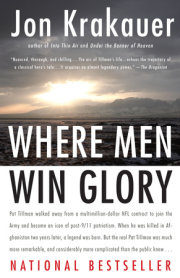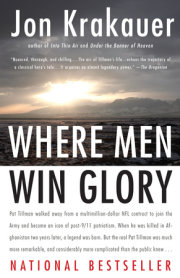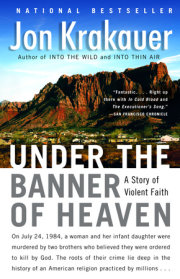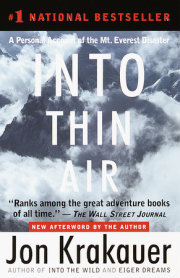CHAPTER ONEDuring Pat Tillman's stint in the Army he intermittently kept a diary. In an entry dated July 28, 2002--three weeks after he arrived at boot camp--he wrote, "It is amazing the turns one's life can take. Major events or decisions that completely change a life. In my life there have been a number." He then cataloged several. Foremost on his mind at the time, predictably, was his decision to join the military. But the incident he put at the top of the list, which occurred when he was eleven years old, comes as a surprise. "As odd as this sounds," the journal revealed, "a diving catch I made in the 11-12 all-stars was a take-off point. I excelled the rest of the tournament and gained incredible confidence. It sounds tacky but it was big."
As a child growing up in Almaden, California (an upscale suburb of San Jose), Pat had started playing baseball at the age of seven. It quickly became apparent to the adults who watched him throw a ball and swing a bat that he possessed extraordinary talent, but Pat seems not to have been particularly cognizant of his own athletic gifts until he was selected for the aforementioned all-star team in the summer of 1988. As the tournament against teams of other standout middle-school athletes got under way, he mostly sat on the bench. When the coach eventually put Pat into a game, however, he clobbered a home run and made a spectacular catch of a long fly ball hit into the outfield. Fourteen years later, as he contemplated life from the perspective of an Army barracks, he regarded that catch as a pivotal moment--a confidence booster that contributed significantly to one of his defining traits: unwavering self-assurance.
In 1990, Pat matriculated at Almaden's Leland High School, one of the top public schools in the San Francisco Bay Area, both academically and athletically. Before entering Leland he had resolved to become the catcher on the varsity baseball team, but the head coach, Paul Ugenti, informed Pat that he wasn't ready to play varsity baseball and would have to settle for a position on the freshman-sophomore team. Irked and perhaps insulted by Ugenti's failure to recognize his potential, Pat resolved to quit baseball and focus on football instead, even though he'd taken up the latter sport barely a year earlier and had badly fractured his right tibia in his initial season when a much larger teammate fell on his leg during practice.
With a November birthday, Pat was among the youngest kids in Leland's freshman class, and when he started high school, he was only thirteen years old. He also happened to be small for his age, standing five feet five inches tall and weighing just 120 pounds. When he let it be known that he was going to abandon baseball for football, an assistant coach named Terry Hardtke explained to Pat that he wasn't "built like a football player" and strongly urged him to stick with baseball. Once Tillman set his sights on a goal, however, he wasn't easily diverted. He told the coach he intended to start lifting weights to build up his muscles. Then he assured Hardtke that not only would he make the Leland football team but he intended to play college football after graduating from high school. Hardtke replied that Pat was making a huge mistake--that his size would make it difficult for him ever to win a starting position on the Leland team, and that he stood virtually no chance of ever playing college ball.
Pat, however, trusted his own sense of his abilities over the coach's bleak predictions, and tried out for the Leland football team regardless. Six years later he would be a star linebacker playing in the Rose Bowl for a national collegiate championship. Twenty months after that he began a distinguished career in the National Football League.
Midway between San Jose and Oakland, the municipality of Fremont rises above the eastern shore of San Francisco Bay, a city of 240,000 that's always existed in the shadow of its flashier neighbors. This is where Patrick Daniel Tillman was born on November 6, 1976. Not far from the hospital where Pat entered the world is a commercial district of pharmacies, chiropractic clinics, and fast-food restaurants bisected by a four-lane thoroughfare. Along three or four blocks of this otherwise unremarkable stretch of Fremont Boulevard, one finds a concentration of incongruously exotic establishments: the Salang Pass Restaurant, an Afghan carpet store, a South Asian cinema, a shop selling Afghan clothing, the De Afghanan Kabob House, the Maiwand Market. Inside the latter, the shelves are stocked with hummus, olives, pomegranate seeds, turmeric, bags of rice, and tins of grapeseed oil. A striking woman wearing a head scarf and an elaborately embroidered vest inlaid with dozens of tiny mirrors stands at a counter near the back of the store, waiting to buy slabs of freshly baked naan. Little Kabul, as this neighborhood is known, happens to be the nexus of what is purportedly the highest concentration of Afghans in the United States, a community made famous by the best-selling novel The Kite Runner.
By loose estimate, some ten thousand Afghans reside in Fremont proper, with another fifty thousand scattered across the rest of the Bay Area. They started showing up in 1978, when their homeland erupted into violence that has yet to abate three decades later. The chaos was sparked by accelerating friction between political groups within Afghanistan, but fuel for the conflagration was supplied in abundance and with great enthusiasm by the governments of the United States and the Soviet Union as each maneuvered to gain advantage in the Cold War.
The Soviets had been lavishing billions of rubles in military and economic aid on Afghanistan since the 1950s, and had cultivated close ties with the nation's leaders. Despite this injection of outside capital, by the 1970s Afghanistan remained a tribal society, essentially medieval in character. Ninety percent of its seventeen million residents were illiterate. Eighty-five percent of the population lived in the mountainous, largely roadless countryside, subsisting as farmers, herders, or nomadic traders. The overwhelming majority of these impoverished, uneducated country dwellers answered not to the central government in Kabul, with which they had little contact and from which they received almost no tangible assistance, but rather to local mullahs and tribal elders. Thanks to Moscow's creeping influence, however, a distinctly Marxist brand of modernization had begun to establish a toehold in a few of the nation's largest cities.
Afghanistan's cozy relationship with the Soviets originated under the leadership of Prime Minister Mohammed Daoud Khan, a Pashtun with fleshy jowls and a shaved head who was appointed in 1953 by his cousin and brother-in-law, King Mohammed Zahir Shah. Ten years later Daoud was forced to resign from the government after launching a brief but disastrous war against Pakistan. But in 1973 he reclaimed power by means of a nonviolent coup d'etat, deposing King Zahir and declaring himself the first president of the Republic of Afghanistan.
A fervent subculture of Marxist intellectuals, professionals, and students had by this time taken root in Kabul, intent on bringing their country into the twentieth century, kicking and screaming if need be, and President Daoud--who dressed in hand-tailored Italian suits--supported this shift toward secular modernity as long as it didn't threaten his hold on power. Under Daoud, females were given opportunities to be educated and join the professional workforce. In cities, women started appearing in public without burqas or even head scarves. Many urban men exchanged their traditional shalwar kameezes for Western business attire. These secular city dwellers swelled the ranks of a Marxist political organization known as the People's Democratic Party of Afghanistan, or PDPA.
The Soviets were Daoud's allies in the push to modernize Afghanistan, at least initially. Aid from Moscow continued to prop up the economy and the military, and under an agreement signed by Daoud, every officer in the Afghan Army went to the Soviet Union to receive military training. But he was walking a perilous political tight rope. While welcoming Soviet rubles, Daoud was an impassioned Afghan nationalist who had no desire to become a puppet of the Soviet president, Leonid Brezhnev. And although Daoud was committed to modernizing his nation, he wanted to move at a pace slow enough to avoid provoking the Islamist mullahs who controlled the hinterlands. In the end, alas, his policies placated few and managed to antagonize almost everyone else--most significantly the Soviets, the urban leftists, and the bearded fundamentalists in the countryside.
At the beginning of his presidency, Daoud had pledged to reform the government and promote civil liberties. Very soon after taking office, however, he started cracking down hard on anyone who resisted his edicts. Hundreds of rivals from all sides of the political divide were arrested and executed, ranging from antimodernist tribal elders in far-flung provinces to urban communists in the PDPA who had originally supported Daoud's rise to power.
For millennia in Afghanistan, political expression has all too often been synonymous with mayhem. On April 19, 1978, a funeral for a popular communist leader who was thought to have been murdered on Daoud's orders turned into a seething protest march. Organized by the PDPA, as many as thirty thousand Afghans took to the streets of Kabul to show their contempt for President Daoud. In typical fashion, Daoud reacted to the demonstration with excessive force, which only further incited the protesters. Sensing a momentous shift in the political tide, most units in the Afghan Army broke with Daoud and allied themselves with the PDPA. On April 27, 1978, MiG-21 jets from the Afghan Air Force strafed the Presidential Palace, where Daoud was ensconced with eighteen hundred members of his personal guard. That night, opposition forces overran the palace amid a rain of bullets. When the sun came up and the gunfire petered out, Daoud and his entire family were dead, and the surrounding streets were strewn with the bodies of two thousand Afghans.
The communist PDPA immediately assumed power and renamed the nation the Democratic Republic of Afghanistan. Backed by the Soviet Union, the new government moved ruthlessly to establish control across the country. During the PDPA's first twenty months at the helm, twenty-seven thousand political dissidents were rounded up, transported to the infamous Pul-e-Charkhi prison on the outskirts of Kabul, and summarily executed.
By this point the violence had instigated a wholesale exodus of Afghans to foreign lands. Because those targeted for elimination by the PDPA tended to be influential mullahs or members of the intellectual and professional classes, many of the refugees who sought sanctuary came from the elite ranks of Afghan society. Two years after Pat Tillman's birth in Fremont, California, Afghans began flocking to the city where he was delivered.
Back in Afghanistan, the brutality of the PDPA inspired a grassroots insurrection that rapidly escalated into full-blown civil war. At the forefront of the rebellion were Muslim holy warriors, the Afghan mujahideen, who fought the communist infidels with such ferocious intensity that in December 1979 the Soviets dispatched 100,000 troops to Afghanistan to quell the rebellion, prop up the PDPA, and protect their Cold War interests in the region.
Nations throughout the world sternly criticized the Soviets for the incursion. The strongest rebuke came from the United States. Expressing shock and outrage over the invasion, President Jimmy Carter called it "the most serious threat to peace since the Second World War," and initiated first a trade embargo and then a boycott of the 1980 Moscow Olympics.
But Carter's righteous indignation was more than slightly disingenuous. Although the U.S. government claimed otherwise in official statements, the CIA had begun purchasing weapons for the mujahideen at least six months before the Soviet invasion, and this clandestine support was intended not to deter Moscow but to provoke it. According to Carter's national security adviser, Zbigniew Brzezinski, the purpose of arming the Afghans was to stimulate enough turmoil in Afghanistan "to induce a Soviet military intervention." Brzezinski, the most fervent cold warrior in the Carter administration, boasted in a 1998 interview that the intent of providing arms to the mujahideen was specifically to draw "the Soviets into the Afghan trap" and ensnare them in a debilitating Vietnam-like debacle.
If that was the plan, it worked. Almost immediately upon occupying the country, the legendary Soviet Fortieth Army found itself neck deep in an unexpectedly vicious guerrilla war that would keep its forces entangled in Afghanistan for the next nine years.
Before the Soviet invasion, Afghanistan was riven by so many intransigent political and tribal factions that the nation had been for all intents and purposes ungovernable. In reflexive opposition to the Soviet occupation, virtually the entire country spontaneously united--a degree of cohesion no modern Afghan leader had ever come close to achieving.
This newly unified opposition was characterized by extraordinary violence. The mujahideen seldom took prisoners in their skirmishes with the invaders. They made a habit of mutilating the bodies of the Soviets they killed in creatively gruesome ways in order to instill terror in those sent to recover the bodies. When the mujahideen did take prisoners, according to Soviet survivors, the infidel soldiers were often gang-raped and tortured.
The Afghans quickly figured out that fighting the Soviets by conventional means was a recipe for certain defeat. Instead of confronting Soviet forces directly with large numbers of fighters, the mujahideen adopted the classic stratagems of insurgent warfare, employing small bands of ten or fifteen men to ambush the enemy and then vanish back into the landscape before the Soviets could launch counterattacks. Soviet soldiers began to refer to the mujahideen as dukhi, Russian for "ghosts." The Afghans took brilliant advantage of the mountainous terrain to stage devastating ambushes from the high ground as Soviet convoys moved through the confines of the valley bottoms. The Soviet cause wasn't helped by a policy designated as "Limited Contingent": Moscow decided to cap the number of Fortieth Army troops in Afghanistan at 115,000, despite the fact that before the invasion Soviet generals had warned that as many as 650,000 soldiers would be needed to secure the country.*
The pitiless style of guerrilla combat waged by the Afghans had an unnerving effect on the Soviets sent to fight them. Morale plummeted, especially as the conflict dragged on year after year. Because opium and hashish were readily available everywhere, drug addiction among the Soviet conscripts was rife. Their numbers were further ravaged by malaria, dysentery, hepatitis, tetanus, and meningitis. Although there were never more than 120,000 Soviet troops in Afghanistan at any given time, a total of 642,000 soldiers served there throughout the course of the war--470,000 of whom were debilitated by disease, addicted to heroin, wounded in battle, or killed.
The tenacity and brutality of the mujahideen prompted the Soviets to adopt ruthless tactics of their own. As they came to realize that it was much easier to kill unarmed civilians than to hunt down the fearsome and elusive mujahideen, the Soviets increasingly focused their attacks on the rural tribespeople who sometimes harbored combatants but didn't shoot back, rather than assaulting the mujahideen directly. Jet aircraft bombed whole valleys with napalm, laying waste to farmland, orchards, and settlements. Helicopter gunships not only targeted villagers but massacred their herds of livestock as well. These calculated acts of genocide went virtually unnoticed outside of Afghanistan.
The shift toward scorched-earth tactics intensified after Konstantin Chernenko became the Soviet general secretary in February 1984 and initiated a campaign of high-altitude carpet bombing. Taking off from bases within the Soviet Union and flying as high as forty thousand feet, safely beyond the range of mujahideen antiaircraft weapons, squadrons of swept-wing, twin-engine Tu-16 Badgers annihilated entire towns.
Copyright © 2009 by Jon Krakauer. All rights reserved. No part of this excerpt may be reproduced or reprinted without permission in writing from the publisher.

